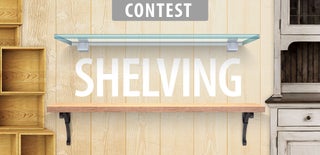Introduction: Make Expensive Looking Shelves on a Small Budget
I was asked by my missus to build some shelves in our front room with no specification other than they are to look "expensive". With this in mind I set about researching different types of shelving and what could be done with our meagre budget of about £100 to fill two large alcoves with shelves.
In the end we both agreed on white powder coated twin slot metal brackets and hangers for a bit of an industrial look with shelves cut, shaped and painted from 18mm WBP plywood. The project did go slightly over budget with an 8x4 sheet of 18mm ply costing £35 cut to strips and the metalwork costing about £60 (half price from a B&Q that was closing but can be found for a similar price on ebay), then £15 for a pot of paint and a few pounds for screws, plugs etc.
If reading isn't your thing I made a video of the build which you can watch here
I am also entering this project into the instructables shelving contest so if you like it then please hit the vote button at the top right.
For UK readers you can get 18mm Plywood here and brackets here.
Step 1: Fitting the Brackets to the Wall
This hanging system comprised two 6ft long vertical brackets to which hangers are fitted which provide a solid base for the plywood shelves to rest on. For two alcoves and nine shelves I needed two long brackets and 18 hangers.
First job was to mark up the wall for hanging the brackets. The first bay was 800mm wide at the top and the other was 760mm wide at the top but being an old house the walls are slightly crooked and that width got slightly more at the bottom for both bays. My strategy therefore was to find the centre point at the top of each bay and make the centreline of each bracket 200mm from this centre point, making the brackets 400mm from each other.
I drilled a hole for the top fixing of each bracket, added a 7mm wall plug and screwed each bracket into place with the widest screw the plug would take to leave all 4 brackets hanging by their top fixing.
I then used a spirit level to ensure each bracket was hanging straight and made sure each pair of brackets was the same distance apart at the top as at the bottom to double check. I then marked the position of all the other fixings before drilling, plugging, and screwing the brackets into place. Each bracket was eventually held up by 6 fixings.
Finally I placed the hangers on the brackets according to where the shelves were going to be built.
Step 2: Building the Shelves
I purchased an 8x4 sheet of 18mm WBP plywood to make the shelves from. The depth of both bays was 370mm so the timber yard very kindly cut my sheet into three pieces 8 foot long and 370mm wide but you could do this yourself with a table saw or a circular saw with a guide.
I used a router with a rounding over bit to create an attractive profile on what would eventually be the front edge of the shelves. As plywood is prone to contain voids I had to go along each profiled edge and fill any holes with wood filler, once this had been left to set I could sand away the excess filler and sand the top and bottom of the ply in readiness to cut out the shelves.
As my bays weren't straight I had to measure the width of the bay at each shelf position and cut each shelf accordingly. To cut each shelf I clamped a straight piece of wood across my plywood to use as a cutting guide and cut with a circular saw. I repeated this until I had all 9 shelves cut to the correct size.
Step 3: Finishing the Shelves
Once all the shelves were cut to size I placed them on their hangers to check their fitting and to mark off the position of the wall brackets on their back edges. This was so I could cut notches so the shelves would fit around the brackets and be flush with the back wall.
To cut the notches I used a router with a narrow cutting bit. I set up a straight piece of wood clamped across the shelf in such a way that it acted as an end stop when I pushed the router forward to leave nice straight notches.
Finally I painted each shelf in satin white paint. The first coat was done with a brush and the following two coats were done with a small roller. In restrospect I would have used a roller from the start but that is a lesson learnt for next time.
Step 4: Fitting the Shelves
The last step was to fit the shelves to the hangers with 40mm screws.
Because these shelves were cut quite precisely I found that some of the excess paint that had collected on the edges of some of the shelves was stopping the shelves fitting correctly. I had to take these back and sand away the excess until they fit.
Step 5: Finished
Some pictures of the final result. I'm happy to say my missus was well pleased with the end result.
If you liked this project, please consider becoming a patron to help me finance more projects in future. Visit my Patreon page to get involved.
Step 6: Tools and Materials
Materials:
1 sheet of 8x4 18mm WBP plywood
4 6ft brackets
18 320mm hangers
2.5 litre pot of satin white paint
80mm screws and wall plugs
40mm screws
Tools
Drill
Circular Saw
Router
Spirit level
Clamps
Brushes and rollers

Participated in the
Shelving Contest 2016













